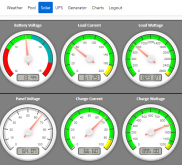If you can set your boost and absorption to the same voltage, it will be best. Anything over 28.4 (14.2) will give you 100% charge current. If you can not set bulk and absorption the same voltage, set bulk to 14.1 and absorption to 14.2. That way, you are canceling the absorption cycle.
Here is a thread that explains this.. Absorption is for SLA (LA) and is required for LA due to it's chemistry and does not apply to LFP and it not changed can do damage to LFP batteries.
I just got a Progressive Dynamics "PD9145ALV 12V Lithium Ion Battery Converter/Charger - 45 Amp" charger off Amazon. Amazon says "Electronic Current Limiting – Automatically reduces output voltage to prevent overheating and possible damage". But the manual that came with it says "When...

diysolarforum.com
I recently set up a 48V off-grid UPS, using the AIMS Global LF Series Pure Sine Wave 4000W 48V inverter/charger. It has multiple battery types, and I've rotated that selector to LiFePo4, which is supposed to bulk charge at a fixed current, until the bank (4S Battle Born 100 AH) reaches 57.6 (=...

diysolarforum.com
I decided to do the Cerbo GX with the touch 50 screen and I didn't want the extra screen that came with the 712. The cerbo has a couple relays and multiple inputs for temp and tank levels and also some digital inputs (which I doubt I'll ever use). It can connect to the inverter and solar...

diysolarforum.com
Hope this helps.. LFP only has one cycle.. Charge / Discharge..
@mandrews44
Thanks for your help, however i have changed my settings from previous....takes a bit of tweaking to get the best out of it, applying possible worst case scenario's.
My settings now are absorption 27.20v and float 27.00, (That is the only settings you can adjust) however this implies the charging going through the following states......bulk 3.40v(27.2v), absorption 1hr @3.40v(27.20), float 3.375v (27.00v).
On the discharge, settings are 3.07v (24.60v), reset 26.60v
These were worked out applying a low current input(simulate a cloudy day) and high current draw to simulate worst case when battery is getting low. Bms HVD set at 3.60v and LVD set at 2.60v, basically to guard against the cell runners, but i shouldn't think they will ever come into play. Just in the process now of guaging what likely capacity i would get from these values applying average usage. Hopefully around 5% up to 85% or 80% in total????
I didnt actually want to drop as low with the discharge level, however there is a minimum 2v addition to the value before the inverter will reset and allow power to be drawn again....which means, if i set the discharge limit any higher, then effectively you would then need to charge the battery back up to full before you got to use it again :-( As it is, it needs about a 33% charge up before it hits 26.60, resetting the inverter.
The other thing i'm thinking of doing, is resetting my BMV712 from its original settings, which were based on initial capacity testing, assuming 280Ah and 3.65v/cell charging. Now that i want it to syncronise as full, when it hits 3.4v and 0.5A, if the capacity at that level is say 85%, i thought about recalibrating the BMV712 to 238Ah , with the charged voltage set as 27.1v, tail current set at 2%(to account for cloudy days) and Time set at say 10 minutes, just to make sure, it is not passing clouds. I should then synchonise to 100% at this stage, ie 100% of useable, not 100% of total capacity. I would just leave my chargery BMS at the original capacity settings, simply to monitor votages and provide protections, nothing else, so not to worried if the capacity on that gets out of sync somewhat, as i wont be reading that one.
Any downsides to my planned set up?
Thanks for any input offered.





